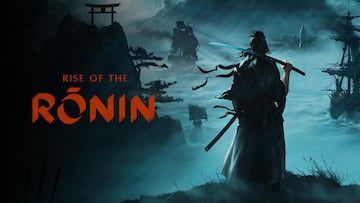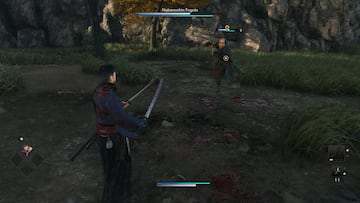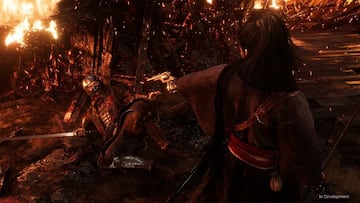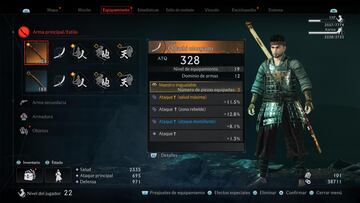Team Ninja
Rise of the Ronin review: Lots of grind, very little charm
Team Ninja’s newest game, Rise of the Ronin, is a very ambitious title that brings the open world formula into their hardcore action style. But does it blend them well? Here’s our review.

For almost a decade, Team Ninja has built a reputation for themselves as one of the best action game developers in the industry. From the ever-fantastic Nioh franchise to last year’s Wo Long: Fallen Dynasty (and even a silly-yet-engaging Final Fantasy spin-off), the team has delivered hardcore souls-likes with grandiose spectacle and hundreds of hours of replayability. This is why their newest game, Rise of the Ronin, is such a disappointing surprise.
We’ve played over 60 hours of Rise of the Ronin, saw almost everything it has to offer, and sadly came out of the experience drained and exhausted. Not because of its difficulty, but because of its jumbled mess of mechanics, concepts, and features seemingly taken from everything they’ve ever done before, hugely impacted by a poorly implemented open-world structure, a relatively hollow and uninteresting world, tedious systems, and poor level design.
But that is not to say that there are no redeeming features to the game. But the games’ issues far outweigh the genuinely good ideas that make the game shine at certain moments. An Interesting setting, meaningful choices that can affect the direction of the story, and some fun setpieces can bring out the best of Team Ninja. But in our opinion it’s not enough to justify the jank that floods the rest of the game.
The last days of the Tokugawa Shogunate.
Rise of the Ronin takes place entirely during the Bakumatsu, the last stretch of the Edo Period of Japan that saw the end of the country’s isolationist policy when they allowed foreigners to open trade. This was a time of turmoil and technological advancement for the region, as foreigners brought with them their cultures. Traditionalists supported the shogunate, looking to maintain their way of life as it had been for hundreds of years, while others looked to integrate foreign ideas and goods into their lives.
As a result, conflict was ever present, with former samurai becoming ronin (warriors that no longer served any master in particular) and fighting for their own benefit. But none of that is your story: you play as one of a pair of “Veiled Edge” blade twins, who are a secret (fictitious) organization of super warriors trained from childhood to work as pairs. During your first mission, you are sent to assassinate Commodore Matthew Perry aboard the fleet of black ships sent by the United States, but just as you’re about to deal the final blow on the villain, you are attacked by a shinobi and separated. After surviving a treasonous attack to your hidden village, you decide to betray your master and leave to search for your blade twin, who you are certain is still alive.
Along the way, you encounter a variety of fictionalized versions of historical figures, from famous wandering Ronin to inventors, politicians, Geisha, and colonizers. It’s a very interesting period with incredibly epic stories, but one that due to its importance doesn’t lend itself to big surprises or massive changes, especially if you’re already familiar with the story.
As such, Team Ninja’s approach to the game’s narrative is much more rigid than what they’ve delivered before. There is a larger focus on cutscenes and conversations with individual characters when compared with games like Nioh and Wo Long, which by its nature gives the game a slower pace than what fans of the studio might be expecting. Overall, this is one of the best aspects of the game, as great care has been given to the characterizations of each player in the story. However, one huge gripe we had with this is the English voice acting, as it’s tonally mismatched with what the game presents. While there is a certain level of silliness in the way characters are written, the English dub feels extremely out of touch with the themes of the story, leaning toward comedy and “hamming up” their performances, with almost everyone having stereotypical Japanese accents that feel… wrong. We highly recommend you play with Japanese audio.
The sharp edge of the blade
Besides the story, there are a few things that Rise of the Ronin does excellently. At the heart of the entire game is the “Bonds” system that tracks your relationship with almost every important character in the game. From fellow Ronin to bandit lords, political figures, and seemingly unimportant merchants, everything you do in the game affects how you are seen by other characters in the world. As you improve your relationships, you basically earn a reputation that lets you level up related bonds, and after rising in these bond ranks you get rewards like armor, money, weapons, and even new fighting styles.
Part of these bonds also translates into a companion system that lets you enter specific missions with a team comprised of your custom character and up to 3 fellow warriors, which sort of makes it feel like a Pokémon-like almost. Throughout the adventure, you meet up with talented fighters, and depending on your choices they may choose to lend their aid in these set missions. When they do, you even get to switch what character you play as in the middle of combat, switching up styles and weapons to face off against certain situations.

As the plot of the game develops over the course of many years, relationships can change heavily, as does the map. You get to visit sprawling vistas in different seasons, and as the conflict evolves so does the kind of fights you’re involved with. All the way you get to make some pretty big decisions with consequences that are not exactly easy to predict. This is probably our favorite part of Rise of the Ronin, as toward the end of the game, you unlock a feature that lets you essentially travel back in time throughout the game’s timeline. As such, you’re never really locked out of content, getting to go back to previous “chapters” to complete side-missions, or change your decisions to alter the events of the present.
It’s one of the most “game-like” mechanics in the title, but it allows players to see everything there is without forcing you into repeating the duller parts of the game. And oh boy, are there some dull parts.
A dull blade makes the most painful cuts
So if all of these sounds so great, why then did we open up this review with such negative comments? The truth of it all is that we like being extremely honest about our experience, and so far we’ve been giving you our opinion about what little we enjoyed from the game. The silver lining that kept us going throughout our time with Rise of the Ronin. Its story, its interesting ideas, and the excellent way it develops such a fantastic period of Japan is all pretty great, even with a little bit of jank to the entire experience.
But when it comes to actual gameplay, Team Ninja somehow messed up badly. The core of the game is its hardcore combat, which by itself is simple enough. Unlike previous titles from the studio, the act of fighting has been simplified to a single button. No longer are there heavy and light attacks, which sometimes makes combat feel like you’re just button-mashing. You get a “counterspark” move, which lets you parry almost every enemy attack in the game when timed correctly, and every weapon type gets up to four special attacks depending on the fighting style you’re using.

Fighting styles are presented as the most important pillar of the combat in Rise of the Ronin: there are almost a dozen main weapon types ranging from Katanas to western sabres, big heavy blades, spears and polearms, and even your bare fists. Each of these weapon types has their own styles or stances, which are categorized as Jin, Chi, and Ten. Each is strong against certain weapons and styles, effectively meaning you have to change up your style during combat to face off against different enemies. It’s like a more complicated version of “rock, paper, scissors”.
Each style brings with it its own animations as well different special attacks, altering your counterspark rhythm and granting you new movesets. They’re all very cool looking, some even referencing previous games from the studio, like a Katana style that gives you Ryu Hayabusa’s attacks from Ninja Gaiden (even the ever-awesome Izuna Drop attack that sees you hug an enemy, jump into the air, and piledriving them into the ground with a spin). But in reality, it’s all superficial: animations and movesets aside, none of it makes much of a difference in gameplay. Only the style’s strengths and advantage over other weapons matters during combat.
If you’re fighting a bandit with an Odachi, only a Chi style lets you break their guard. If they have katanas or dual blades, only Ten Style lets you break their guard and do damage. If its light weapons, only Jin works. There are special styles that have none of these types, making them neutral, but that only means they work but are weaker. The main difference between all of them is how good they are at reducing an enemy’s Ki (basically their stamina bar) to let you do a critical attack. Even their special attacks may look different, but in reality, they all fall into the same category of attacks that boil down to flashier, longer attacks.

It seems like a botched attempt at making the game more accessible to new players, but one that results in most of the fantastic action of games like Wo Long being mostly absent from the game. It’s not enough that there are zero fantastic elements to the game, meaning you mostly fight human bandits, other samurai, and a few dogs and out-of-place giant animals, combat is actually boring when you master it. And speaking of fantastical elements, even when the game attempts to root itself in historical accuracy and reality, for some reason you still get elemental buffs? You can ignite your sword on fire, coat it with poison, there is water damage and electric damage, and many more special ailments… all of it taken straight from previous, mythology-drenched titles.
Making things worse the controller layout is extremely convoluted even when combat was simplified. You can have up to two weapons equipped at all times, two sub-weapons, three item loadouts, each weapon has three styles to choose from, each style four special attacks. The four face buttons are assigned one to attack, one to counter, one to dodge, one to jump. Running is initiated by dodging and holding down the button. You interact with everything by pressing R1, block with L1, except during combat where holding down R1 lets you press the rest of the buttons to change loadouts or weapons. L1+Up changes which character you’re playing as (in missions). There’s a grapple hook on R2, and L2 uses your subweapon, unless it’s a ranged weapon you can aim, but when aiming you can select your ammo type… there are so many convoluted commands that will twist your hands while playing, that you’ll probably keep making mistakes while playing up until the last hours of the experience.
There is so much complexity in the game just for the sake of it being complex, that after a while things start to get annoying and boring. And it all extends to basically every other aspect of the game. It’s open world is massive, filled with camps of enemies to defeat, but it’s always the same kinds of enemies. Clearing these unlocks more points of interest in its respective region. You can find landmarks to visit, cats to pet, shrines to pray at, minigames to complete… but all of it only works to fill a completionist list for the sake of high tier loot.

But loot is the worst offender of them all. New weapons and armor pieces, accesories, and crafting ingredients are thrown at you non-stop during the entirety of the game. You can find it as enemy drops, in chests, lying in the ground. You get them for completing challenges, for clearing camps, for talking to people, for petting a cat, for getting an achievement. Everything you do rewards you with so much loot, that almost immediately it loses all meaning. You can get a strong sword one moment, start to clear a camp, and suddenly you find a legendary weapon! Which is cool, except that you change to it after comparing stats and skills, alter your gear again, check weapon styles, and now you can get back to the small camp you’re fighting in. So you do, and you kill the rest of the enemies. Each one just dropped 3 more pieces of loot, and when you check, you already found a weapon with better stats.
This happens constantly, always getting meaningless stat upgrades with everything you get. Your inventory has thousands of slots to hold the gear you find, and if you’re not carefully getting rid of all the junk you find, you’ll suddenly find yourself lost in worthless weapons all over the place. There is an gear upgrade system, which in theory lets you keep your favorite weapons and armor for a longer time, but its costs are too high and the improvements are worthless when you can just keep playing and find something better not 15 minutes later. As such, until the very end of the game when you already have the strongest version of the weapons you like, it’s useless to engage in many of the crafting systems.
A massive step backward for Team Ninja
We could keep musing about things that annoy us from Rise of the Ronin, like it’s poor performance, subpar graphics, or astonishingly stiff movement both in its gameplay or from the characters in cutscenes. Or the fact that their “inspiration” from Ghost of Tsushima translated in terribly obvious copying of even camp-clearing animations and the way time “jumps ahead” after completing a mission to show your hero sitting down after completing it. And we probably will, but not here.
Our frustration with Rise of the Ronin comes from the fact that we’ve loved every previous title the studio has released (yes, even Stranger of Paradise had its own weird charm), but somehow they managed to deliver one of their worst experiences so far with Ronin. Gone is the charm that Nioh and Wo Long gave us, replaced instead with pseudo-realism and a boring and over-stuffed open world that makes the failings of Team Ninja’s level design painfully apparent.

The worst part is that, as a whole, the experience isn’t a bad one (apart from its graphics and performance). But when compared with what came before from the same developers, it is a huge disappointment. It’s not that it’s a bad game, it’s that it’s a mediocre, bland experience, and one that we’re in absolutely no rush to go back to.


